Sumatran Elephant
Elephas Maximus Sumatranus
Less than 2,000 left in the wild!
Advertisement
Sumatran Elephant Scientific Classification
- Kingdom
- Animalia
- Phylum
- Chordata
- Class
- Mammalia
- Order
- Proboscidea
- Family
- Elephantidae
- Genus
- Elephas
- Scientific Name
- Elephas Maximus Sumatranus
Read our Complete Guide to Classification of Animals.
Sumatran Elephant Conservation Status
Sumatran Elephant Facts
- Main Prey
- Grass, Fruit, Roots
- Distinctive Feature
- Long trunk and large feet
- Habitat
- Rainforest and tropical woodland
- Predators
- Human, Tiger
- Diet
- Herbivore
- Average Litter Size
- 1
- Lifestyle
- Herd
- Favorite Food
- Grass
- Type
- Mammal
- Slogan
- Less than 2,000 left in the wild!
View all of the Sumatran Elephant images!
“Less than 2,000 left in the wild!”
The smallest subspecies among the Asian elephants, the Sumatran elephant is native to Sumatra Island, one of the Sunda Islands, in Indonesia. Belonging to the Elephantidae family, they are among the largest mammals on land. Sumatran elephants are highly intelligent animals with excellent memory. Like all elephants, the Sumatran needs lots of land area to thrive and prefers lowland environments.
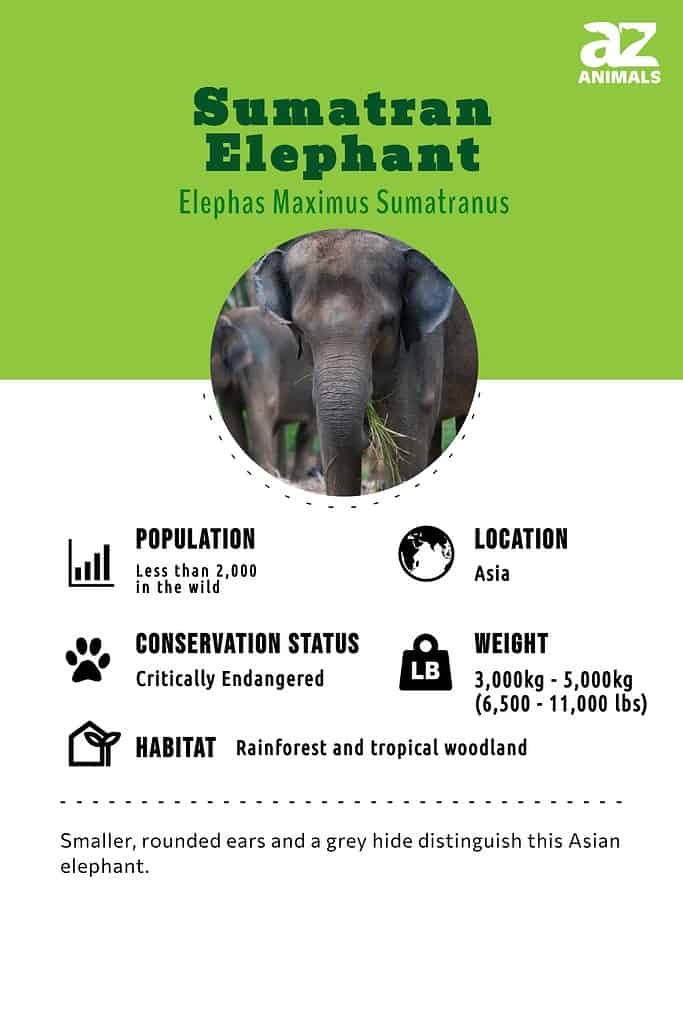

Sumatran elephants have smaller tusks than their African counterparts – with females being tuskless.
Five Sumatran Elephant Facts
- Because they are so heavy, elephants are not able to jump or do other activities that require all four feet to be off the ground at one time.
- This species has 20 pairs of ribs.
- This animal can run up to 27mph.
- The female of the species rarely has tusks. If they do, they are small and hidden.
- Sumatran Elephants mourn the loss of others.
Scientific name
The scientific name of this animal is Elephas Maximus Sumatranus. It’s a member of the Elephantidae family and the Mammalia class.
The Sumatran elephant is a subspecies of the Asian elephant. The Greek word elephas refers to ivory or tusks. Maximus is a Latin word meaning “the greatest.”
The Borneo Elephant, the Indian Elephant, and the Sri Lankan Elephant are all subspecies of Asian elephants just like the Sumatran elephant. Other species in the Elephantidae family are African Bush elephants and African Forest elephants.

The Sumatran is the smallest subspecies of an Asian elephant.
©leolintang/Shutterstock.com
Evolution
Fossil records show that extinct proboscideans, large mammals with trunks and tusks, have been identified on every continent except Australia and Antarctica. The ancestor of these animals originated in Africa around 40 million years ago – and was trunkless. Moeritherium, about the size of modern pigs, is believed to be the animal that led to modern elephants – and is also an ancestor of manatees and dugongs.
Gomphotheres, tusked but with no trunks, were herbivores that roamed Africa, Eurasia, and the Americas during the Miocene, Pliocene, and Pleistocene epochs. These animals had given rise to the elephantids by the time of their extinction. Around the beginning of the Pleistocene, 5 million years ago, the Elephas and Mammuthus arrived to be followed by Loxodonta. Loxodonta remained in Africa while Mammuthus ranged to Eurasia.
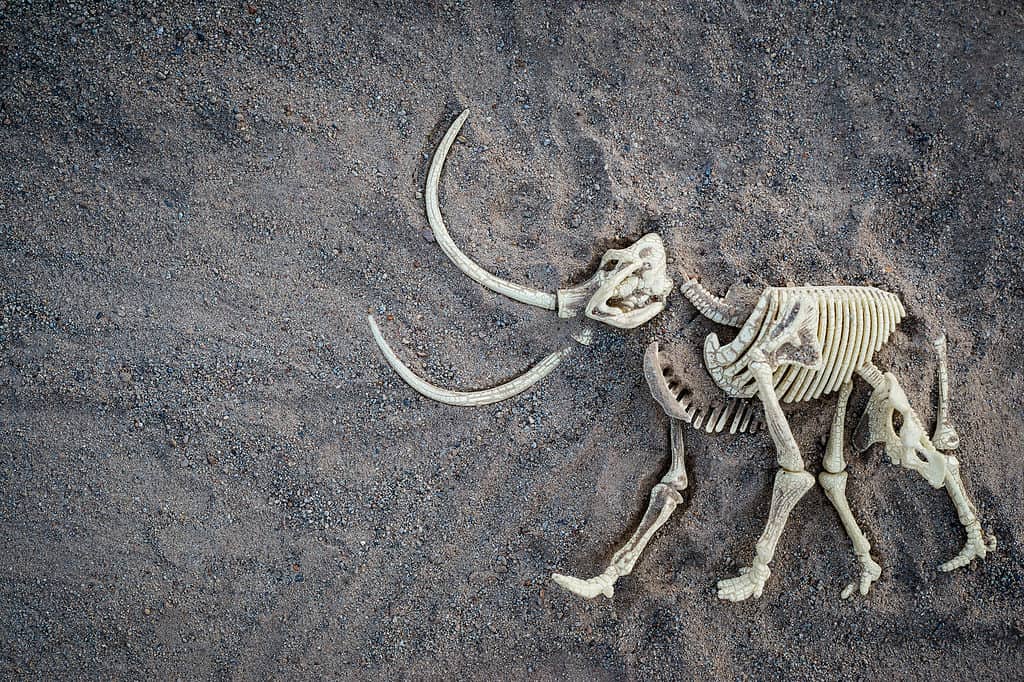
The
woolly mammoth
and
Elephas platycephus,the ancestor of the Sumatran elephant, lived during the Pleistocene.
©Lesterman/Shutterstock.com
The ancestor of the Asian elephant, Elephas platycephus, arrived during the Pleistocene, as did the Mammuthus primigenious, the woolly mammoth. The African elephant, Loxodonta, appeared 1.5 million years ago and is the newest elephant species in evolutionary terms. It is larger than the Asian elephant in size and both males and females have tusks.
Anatomy and Appearance
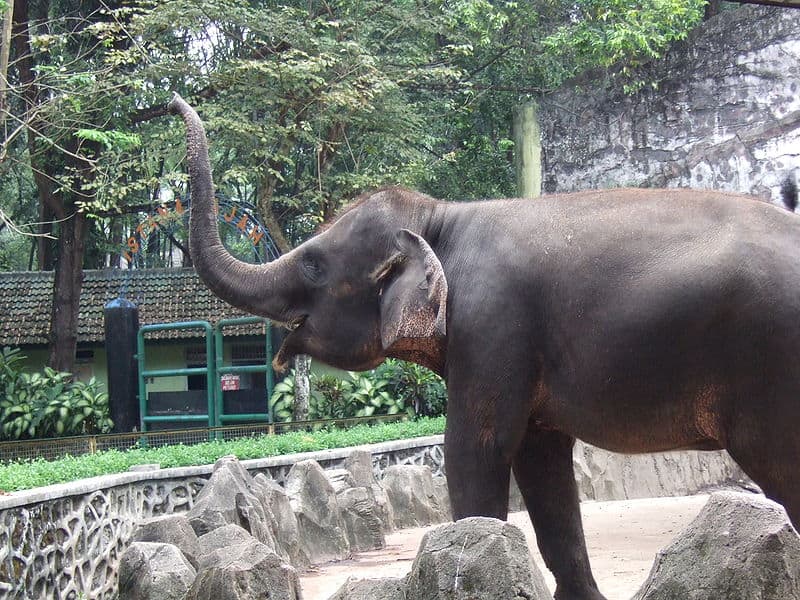
Sumatran elephants have smaller, more rounded ears than their African counterparts.
Appearance
Sumatran elephants are gray in color and are nearly bald. Compared to African elephants, their ears are smaller and have a more rounded shape. Males have small tusks compared to other elephant species, while females may not have any at all. Sumatran elephants have long trunks with many functions. The light gray color can act as camouflage in their environment. They can grow to be about 10-and-a-half feet tall and about 20 feet long. These elephants can reach a weight of between 4,400 and 8,800 pounds – about the same weight as two-and-a-half cars.
The Elephant’s Trunk
The most prominent feature of an elephant is its trunk – with more than 60,000 muscles enabling the elephant to perform many different functions. One use is to soak up water and then pour it into their mouth to drink. An elephant’s trunk can be used to smell, breathe, shower, grab things, and trumpet to communicate.
Behavior
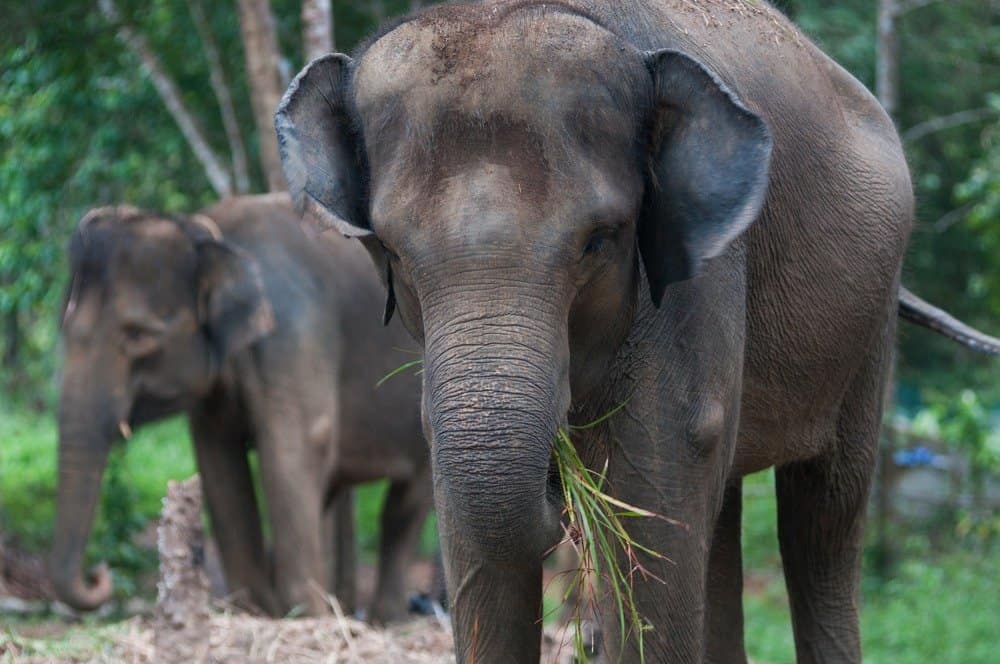
Elephant herds are led by a matriarch and work together to protect their young.
©robbihafzan/Shutterstock.com
Elephants are extremely social animals and live in herds led by a matriarch, typically the oldest female. Herds are typically made up of females and their calves, 20-35 individuals. Elephants share a close bond with the members of their herd and work together to protect their young.
Elephants also use infrasound, which is low-frequency sounds that are below what humans can hear. They are sensitive to these sounds and also use them to communicate. Only a handful of mammals have this ability.
Habitat

Sumatra Island is the only place where tigers, rhinos, orangutans, and elephants live together in the wild.
©Fabio Lamanna/Shutterstock.com
Sumatran elephants, one of three subspecies of Asian elephants, reside in the wild only in Indonesia, on the Island of Sumatra. They prefer moist rainforest environments. They will also travel to rivers and hills, depending on their needs. Sumatran elephants have thick skin to protect them from harsh weather and injuries.
Elephants are important to a healthy ecosystem. When they defecate, they disperse seeds all over, helping to grow plants and replenish forests. Unfortunately, much of their natural habitat has been destroyed by deforestation and human development for agriculture.
Diet
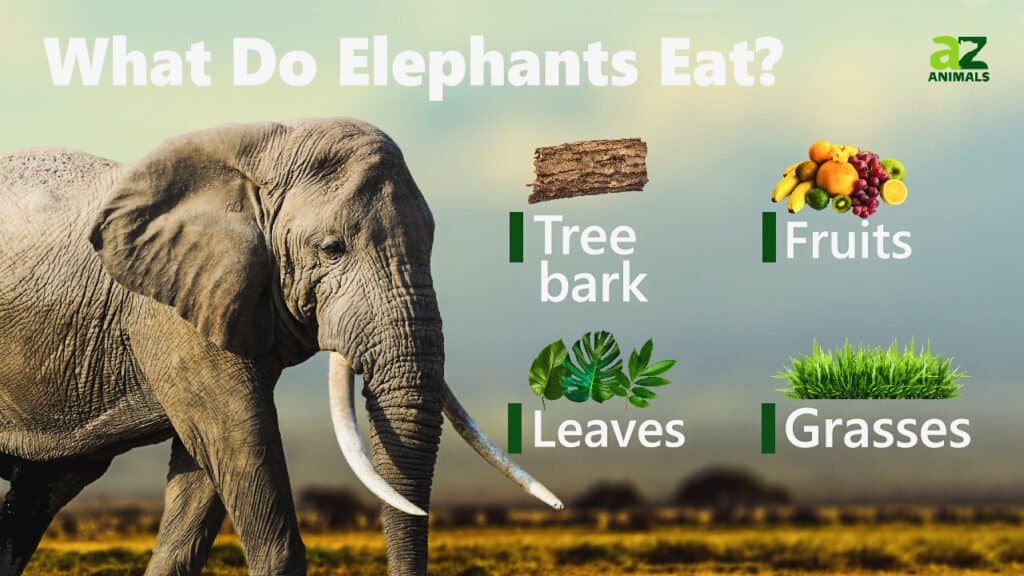
Sumatran elephants are herbivores therefore, their diet mainly consists of leaves, grass, and fruit. They will also eat bark and seeds. Their diet consists of over 100 species of plants and vegetation. They spend a lot of time eating. They can eat up to 150 kg of food (about the average weight of an adult panda) and up to 200 liters of water a day. That’s equal to over 52 one-gallon milk jugs.
Predators and Threats
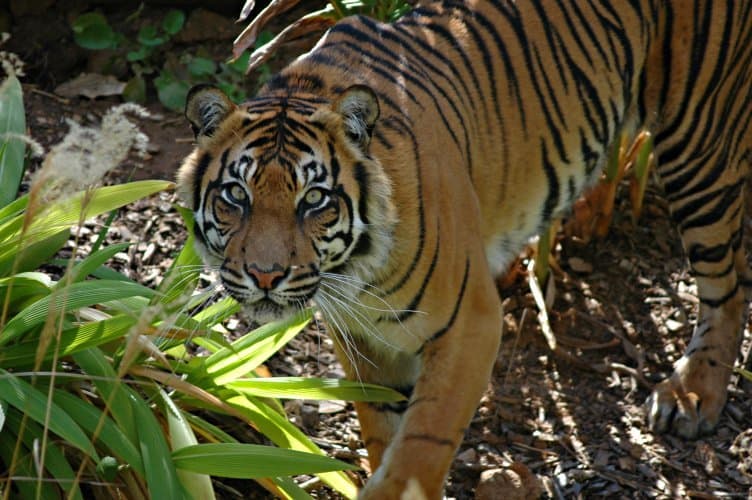
Sumatran tigers prey on baby elephants.
©I, Kevin1243, CC BY-SA 3.0, via Wikimedia Commons – License
Elephants generally have few predators, besides humans, due to their large size. However, young elephants sometimes fall prey to the Sumatran tiger. Tigers will target baby elephants that are small enough to attack or who wander from the herd. The Sumatran tiger is also endangered.
Poaching is another threat posed to these animals. Elephants are hunted for their ivory tusks. Although there are bans against poaching, it remains a threat specifically to male Sumatran elephants. Deforestation and development also play a substantial role in the decline of the Sumatran elephant population. Plantations for palm oil and farmlands are some of the main complications for these animals. This leads to habitat loss and can cause migratory routes to be cut off, making it difficult for the elephants to get around and essentially breaking up the community’s habitat into much smaller, detached areas. This is called fragmentation and has a big impact on the population.
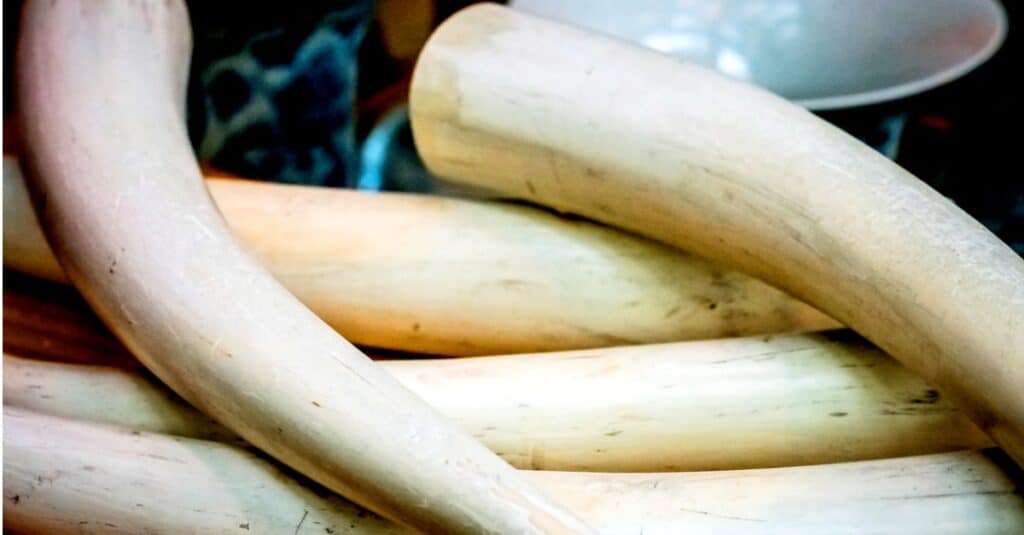
Although it has been banned, ivory poaching remains a threat to Sumatran elephants.
©iStock.com/MagicColors
Conservation Status
Sumatran Elephants’ conservation status is critically endangered. Conservation efforts being made by World Wildlife Fund include “reducing human-elephant conflict” and “securing healthy forests.” WWF came up with a groundbreaking program called the “Elephant Flying Squad,” which uses trained elephants to patrol and essentially keep them separate from humans. Elephants will commonly find nearby farms or crops, and they will trample plants and eat humans’ harvests. Keeping the elephants away from these areas can help save both animal lives and human lives. You can learn more about conservation efforts and what you can do to help here. You can even “adopt” an elephant and be a part of the solution. Of course, you won’t literally own an elephant, but your donations will make a difference.
Learn more about the most endangered species in the world here.
Reproduction, Babies, and Lifespan
Adult male Sumatran elephants, called bulls, deal with a condition called “musth” during mating season. They have a higher level of testosterone that drives their mating instincts. It is similar to a dog going into heat or a rut in deer. The bulls become aggressive and will fight other males to mate with a female. An adult female elephant is called a cow. Once pregnant, the gestation period for a Sumatran elephant is between 18 and 22 months. Cows give live birth, and the average litter size is one, although they carry twins very rarely. The birthing process of an elephant is very quick. It usually only takes about 10 seconds. Compared to humans, that is incredibly fast. The average birth weight of a Sumatran elephant is 100kg. That’s roughly 220.5 pounds as an infant, equivalent to 30 bricks.
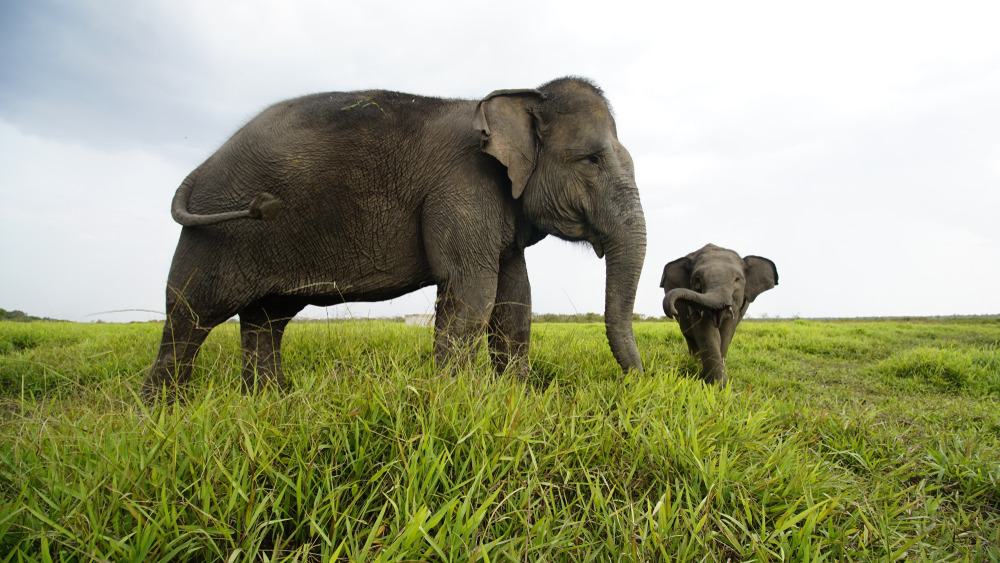
Baby Sumatran elephants, like other elephant calves, stay with their mothers for around five years.
©dindaariztha/Shutterstock.com
A baby elephant is called a calf. It stays with the mother elephant for about five years, when it is weaned and big enough to be on its own. A calf survives on its mother’s milk until it is old enough to eat foods such as grass and leaves. Typically, female calves stay with the herd, while males go off on their own after reaching sexual maturity.
Baby Sumatran elephants can stand on their legs only 10 to 30 minutes after birth, which is similar to Giraffe calves, who can also stand on their own within 30 minutes of being born.
Sumatran elephants typically live to be between 60 and 70 years old but have been known to live up to 75 years in captivity. After age 60, female elephants no longer reproduce.
Elephant Population
There are between 2,400 and 2,800 Sumatran elephants remaining in the world. In the wild, specifically in Asia, there are less than 2,000 Sumatran Elephants in 25 fragmented habitats. The remaining elephants are living in captivity.
The population continues to decline and is under threat of becoming extinct. The Sumatran elephant is considered critically endangered at this time according to the International Union for the Conservation of Nature (IUCN). If the population continues to decline as expected, Sumatran elephants will soon be extinct in the wild. In fact, they could be gone in as little as 30 years.
Sumatran Elephants In the Zoo
You can see Sumatran elephants at Australia Zoo. You can even book a private encounter.
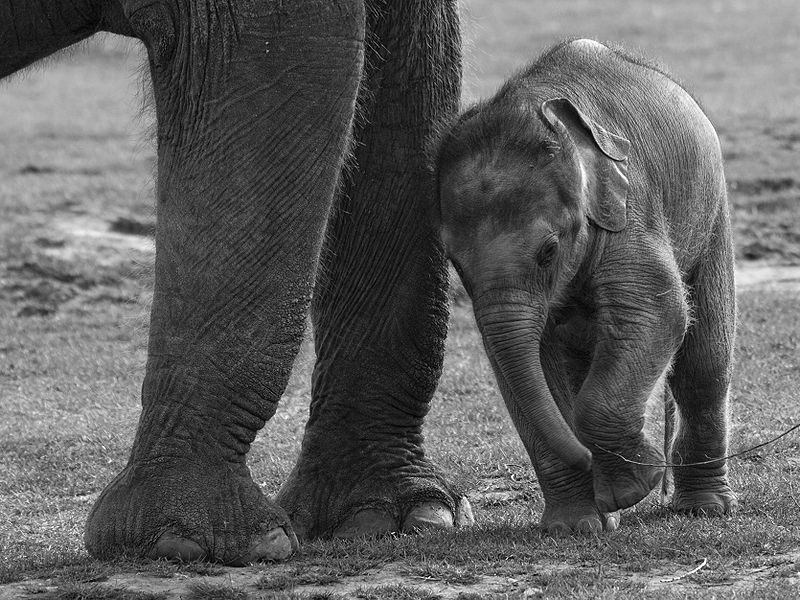
Baby Asian elephant with its mother.
©William Warby, CC BY 2.0, via Wikimedia Commons – License
Sumatran Elephant FAQs (Frequently Asked Questions)
Are Sumatran elephants carnivores, herbivores, or omnivores?
All elephants, including Sumatran elephants, are herbivores.
How many Sumatran elephants are left?
There are only around 2,400 to 2,800 left in the world.
Why is the Sumatran elephant going extinct?
Deforestation and poaching are the main factors causing the population to steadily decline and become critically endangered.
How long do Sumatran elephants live?
Sumatran elephants generally live to be 60-70 years old.
What Kingdom do Sumatran Elephants belong to?
Sumatran Elephants belong to the Kingdom Animalia.
What phylum to Sumatran Elephants belong to?
Sumatran Elephants belong to the phylum Chordata.
What class do Sumatran Elephants belong to?
Sumatran Elephants belong to the class Mammalia.
What family do Sumatran Elephants belong to?
Sumatran Elephants belong to the family Elephantidae.
What order do Sumatran Elephants belong to?
Sumatran Elephants belong to the order Proboscidea.
What type of covering do Sumatran Elephants have?
Sumatran Elephants are covered in Leathery skin.
What genus do Sumatran Elephants belong to?
Sumatran Elephants belong to the genus Elephas.
In what type of habitat do Sumatran Elephants live?
Sumatran Elephants live in rainforests and tropical woodlands.
What is the main prey for Sumatran Elephants?
Sumatran Elephants eat grass, fruit, and roots.
What are some predators of Sumatran Elephants?
Predators of Sumatran Elephants include humans and tigers.
What are some distinguishing features of Sumatran Elephants?
Sumatran Elephants have long trunks and large feet.
How many babies do Sumatran Elephants have?
The average number of babies a Sumatran Elephant has is 1.
What is an interesting fact about Sumatran Elephants?
There are less than 2,000 Sumatran Elephants left in the wild!
What is the scientific name for the Sumatran Elephant?
The scientific name for the Sumatran Elephant is Elephas Maximus Sumatranus.
How fast is a Sumatran Elephant?
A Sumatran Elephant can travel at speeds of up to 27 miles per hour.
Thank you for reading! Have some feedback for us? Contact the AZ Animals editorial team.
Sources
- David Burnie, Dorling Kindersley (2011) Animal, The Definitive Visual Guide To The World's Wildlife
- Tom Jackson, Lorenz Books (2007) The World Encyclopedia Of Animals
- David Burnie, Kingfisher (2011) The Kingfisher Animal Encyclopedia
- Richard Mackay, University of California Press (2009) The Atlas Of Endangered Species
- David Burnie, Dorling Kindersley (2008) Illustrated Encyclopedia Of Animals
- Dorling Kindersley (2006) Dorling Kindersley Encyclopedia Of Animals
- David W. Macdonald, Oxford University Press (2010) The Encyclopedia Of Mammals

















